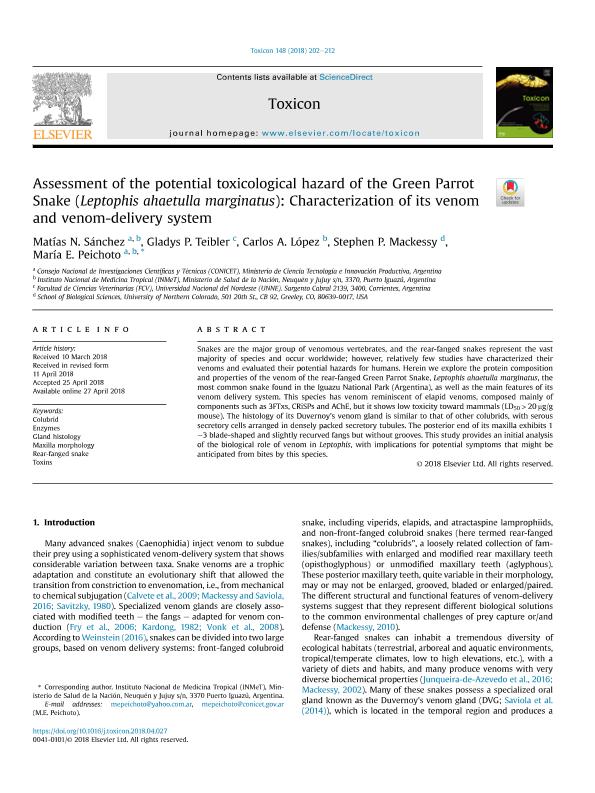Mostrar el registro sencillo del ítem
dc.contributor.author
Sanchez, Matias Nicolas

dc.contributor.author
Teibler, Gladys Pamela

dc.contributor.author
López, Carlos Ariel

dc.contributor.author
Mackessy, Stephen

dc.contributor.author
Peichoto, María Elisa

dc.date.available
2019-10-21T22:45:31Z
dc.date.issued
2018-06
dc.identifier.citation
Sanchez, Matias Nicolas; Teibler, Gladys Pamela; López, Carlos Ariel; Mackessy, Stephen; Peichoto, María Elisa; Assessment of the potential toxicological hazard of the Green Parrot Snake (Leptophis ahaetulla marginatus): Characterization of its venom and venom-delivery system; Pergamon-Elsevier Science Ltd; Toxicon; 148; 6-2018; 202-212
dc.identifier.issn
0041-0101
dc.identifier.uri
http://hdl.handle.net/11336/86790
dc.description.abstract
Snakes are the major group of venomous vertebrates, and the rear-fanged snakes represent the vast majority of species and occur worldwide; however, relatively few studies have characterized their venoms and evaluated their potential hazards for humans. Herein we explore the protein composition and properties of the venom of the rear-fanged Green Parrot Snake, Leptophis ahaetulla marginatus, the most common snake found in the Iguazu National Park (Argentina), as well as the main features of its venom delivery system. This species has venom reminiscent of elapid venoms, composed mainly of components such as 3FTxs, CRiSPs and AChE, but it shows low toxicity toward mammals (LD50 > 20 μg/g mouse). The histology of its Duvernoy's venom gland is similar to that of other colubrids, with serous secretory cells arranged in densely packed secretory tubules. The posterior end of its maxilla exhibits 1–3 blade-shaped and slightly recurved fangs but without grooves. This study provides an initial analysis of the biological role of venom in Leptophis, with implications for potential symptoms that might be anticipated from bites by this species.
dc.format
application/pdf
dc.language.iso
eng
dc.publisher
Pergamon-Elsevier Science Ltd

dc.rights
info:eu-repo/semantics/openAccess
dc.rights.uri
https://creativecommons.org/licenses/by-nc-sa/2.5/ar/
dc.subject
COLUBRID
dc.subject
ENZYMES
dc.subject
GLAND HISTOLOGY
dc.subject
MAXILLA MORPHOLOGY
dc.subject
REAR-FANGED SNAKE
dc.subject
TOXINS
dc.subject.classification
Otras Ciencias Veterinarias

dc.subject.classification
Ciencias Veterinarias

dc.subject.classification
CIENCIAS AGRÍCOLAS

dc.title
Assessment of the potential toxicological hazard of the Green Parrot Snake (Leptophis ahaetulla marginatus): Characterization of its venom and venom-delivery system
dc.type
info:eu-repo/semantics/article
dc.type
info:ar-repo/semantics/artículo
dc.type
info:eu-repo/semantics/publishedVersion
dc.date.updated
2019-09-27T14:58:29Z
dc.journal.volume
148
dc.journal.pagination
202-212
dc.journal.pais
Estados Unidos

dc.description.fil
Fil: Sanchez, Matias Nicolas. Consejo Nacional de Investigaciones Científicas y Técnicas. Centro Científico Tecnológico Conicet - Nordeste; Argentina. Ministerio de Salud. Instituto Nacional de Medicina Tropical; Argentina
dc.description.fil
Fil: Teibler, Gladys Pamela. Universidad Nacional del Nordeste. Facultad de Ciencias Veterinarias; Argentina
dc.description.fil
Fil: López, Carlos Ariel. Ministerio de Salud. Instituto Nacional de Medicina Tropical; Argentina
dc.description.fil
Fil: Mackessy, Stephen. Univeristy of Northern Colorado; Estados Unidos
dc.description.fil
Fil: Peichoto, María Elisa. Consejo Nacional de Investigaciones Científicas y Técnicas. Centro Científico Tecnológico Conicet - Nordeste; Argentina. Ministerio de Salud. Instituto Nacional de Medicina Tropical; Argentina
dc.journal.title
Toxicon

dc.relation.alternativeid
info:eu-repo/semantics/altIdentifier/url/https://www.sciencedirect.com/science/article/pii/S0041010118301703
dc.relation.alternativeid
info:eu-repo/semantics/altIdentifier/doi/https://doi.org/10.1016/j.toxicon.2018.04.027
Archivos asociados
